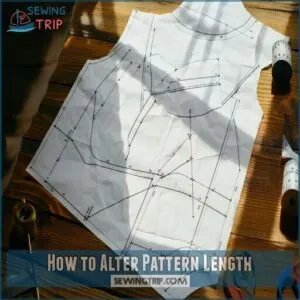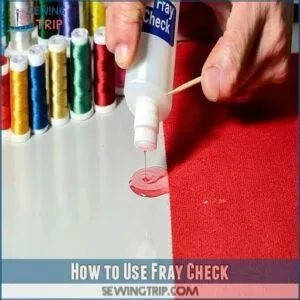This site is supported by our readers. We may earn a commission, at no cost to you, if you purchase through links.
Pattern alteration tips and tricks can turn any garment into a custom masterpiece.
Start by checking the pattern size—it’s tempting to eyeball it, but precise measurements are non-negotiable.
To lengthen or shorten, use the designated adjustment lines, then true up the edges for smooth seams.
Adjust bust darts to hit the right spot; they should point to the fullest part of the bust, not wander off like a lost GPS.
Need a full bust adjustment? Add width without distorting the armhole.
Small tweaks to hips, shoulders, and waistlines guarantee balance.
The secret? Patience, precision, and a smidge of practice—worth every stitch.
Table Of Contents
Key Takeaways
- Check measurements against the pattern and use adjustment lines to alter length, ensuring smooth seams and balanced seams.
- Adjust bust darts to align with your bust apex, and use full or small bust adjustments when needed for a better fit.
- Modify hips, shoulders, or waistlines with precision to achieve a flattering fit and comfortable fit.
- Transfer alterations to all pattern pieces, maintaining alignment, and true up seams for seamless results.
Altering Pattern Length
Adjusting a pattern’s length is key to creating garments that fit your unique proportions.
Adjusting pattern length unlocks custom fits, ensuring every garment complements your unique proportions with seamless style and precision.
Whether you’re adding or removing length, a few precise steps will guarantee smooth seams and a professional finish.
Lengthening and Shortening Patterns
Lengthening or shortening patterns is key for a perfect fit. Compare your body length to the pattern, then draw length adjustment lines perpendicular to the grainline.
Move the pieces vertically for balanced adjustments. Don’t forget pattern truing to smooth edges! Multiple lines may spread differences evenly.
Accurate body measurements are essential for precise pattern alterations. These sewing pattern alterations avoid frustrating clothing mishaps during sewing projects.
Adding Length to a Pattern
When adding length to a pattern, small tweaks make a big impact.
Slice the pattern at your marked line and insert paper for support.
Use these tips:
- Grainline Impact: Align carefully to maintain fabric flow.
- Paper Placement: Stabilize pattern pieces during changes.
- Incremental Additions: Add length gradually for precision.
- Edge Truing: Smooth edges for seamless sewing.
Consider using specialized pattern adjustment tools for best results.
Adapt with confidence!
Removing Length From a Pattern
You’ve tackled adding length; now let’s address removing it.
Mark alteration lines across the pattern where shortening is needed.
Use Pattern Folding techniques along these lines for Balanced Adjustments.
Match seams and make certain edges align for smooth sewing.
Double-check other pattern pieces impacted too!
Many sewists find success using the precise folding techniques.
Pattern FoldingSeam Matching
Balanced Adjustments
Bust Adjustments
Bust adjustments guarantee your garment fits comfortably and flatters your shape.
Bust adjustments ensure your garment fits beautifully, offering both comfort and a flattering, custom-tailored look.
By tweaking darts or altering the pattern to accommodate cup size, you’ll create a professional finish that feels custom-made.
Moving Bust Darts
To reposition a bust dart, cut along its intake and shift it to your desired spot, keeping the legs parallel.
Blend gaps smoothly to maintain the design’s flow. Test your adjustment on muslin first—it saves headaches!
For precision, a sloper guarantees accuracy. Pair this with the slash and spread method when tackling full or small bust tweaks.
Confirm accurate dart placement by locating the bust apex, using complete concepts and ensuring accurate adjustments for the best results.
Full Bust Adjustments
If you’re shifting bust darts but still struggling with fit, it’s time for a full bust adjustment (FBA).
Using FBA techniques like the slash and spread method adds room where it matters without messing up the rest.
Combine pattern spreading with muslin fitting for accurate adjustments.
Don’t forget: proper dart manipulation and cup size checks make or break the fit.
Small Bust Adjustments
When a pattern feels bulky at the bust, it’s time for a small bust adjustment (SBA).
Start by tracing the bodice, then overlap pattern pieces near the bust apex.
Use precise dart manipulation to guarantee smooth lines. Test adjustments on muslin for accuracy and refine the fit.
SBA techniques, like pattern overlap, guarantee a streamlined alteration and perfect bodice fit.
Body Alterations
Getting your garment to hug your body in all the right places starts with precise body alterations.
Whether you’re adjusting hips, shoulders, or waistlines, small tweaks to the pattern can make all the difference in achieving a comfortable, flattering fit.
Hip Width Adjustments
For better-fitting slacks or skirts, hip alteration is key.
Compare your hip measurement to the pattern’s and slash-and-spread or tuck as needed.
For curvy figures, blend lines smoothly to avoid uneven seams.
Muslin fitting helps check your fit adjustment without risking expensive fabric.
This simple pattern alteration guarantees your garment alteration suits your body and looks polished with a good fit.
Shoulder Width Adjustments
If your garment pinches at the shoulders or droops unnaturally, it’s time for a shoulder adjustment.
For broad shoulders, expand the pattern slightly, balancing armscye fit. Address narrow shoulders by carefully overlapping edges.
Sloping shoulder adjustments involve lowering seams; straight shoulder adjustments require evening lines.
Precision guarantees that muscular backs or delicate frames both enjoy perfect fit with thoughtful pattern alterations, ensuring a well-tailored garment for any body type, including those with muscular backs.
Waistline Adjustments
After tweaking shoulder width, let’s talk waist adjustment.
Adding fullness or shaping at the waist transforms garment fit, use waist darts or contouring seams for definition, or lower the waistline for a relaxed vibe.
When doing sewing pattern adjustments, verify your pattern alteration aligns with body measurements, as small garment adjustments here can make clothing look clean and polished—truly worth the effort to achieve a relaxed vibe.
Measuring Garments
Measuring garments accurately is the key to creating patterns that fit like they’re made just for you.
By using well-fitting clothes as a reference, you can guarantee your sewing projects stay stress-free and precise.
Selecting The Right Pattern Size
Choosing the right size starts with accurate body measurements.
Don’t rely on your ready-to-wear size—patterns work differently.
Consult size charts, considering these factors:
- Use your largest measurement for size selection.
- Factor in ease consideration for comfort and movement.
- Think about your fabric choice and how it affects fit.
- Match pattern styles with your garment goals.
Measuring for Accurate Fit
Your tape measure is your best friend for Body Measurement Accuracy.
Double-check clothing measurements like bust, waistline, and hips to avoid pattern fitting mishaps.
Sit while measuring pants for Seated Position Measurement, ensuring comfort.
Compare garment measurements to the pattern for a Custom Fit Adjustment.
For best results, remember to follow rules for accurate body measurements.
Precision is key—small inaccuracies can turn perfect fit dreams into wardrobe disasters!
Customizing Garment Components
Patterns aren’t one-size-fits-all, so grab your measuring tape and get specific.
Whether it’s sleeve alterations for better movement or neckline shaping for elegance, pattern fitting makes all the difference.
Don’t forget cuff adjustments or pocket variations—they’re small tweaks that pack big personality.
Alteration techniques like collar modifications let you customize garments effortlessly, turning simple designs into clothing you’ll actually love wearing, with techniques like collar modifications and pattern fitting.
Applying Alterations
When applying alterations, start by carefully transferring your changes to all affected pattern pieces, ensuring proper alignment and balance.
Take your time to check seam allowances, darts, and grain lines, so everything works seamlessly in the final garment.
Transferring Alterations to Patterns
When transferring alterations to your pattern, precision is key for success. Start by making symmetrical alterations on your toile transfers. Mark notch placements and add seam allowances back after adjustments.
For best results, consider investing in essential pattern tools.
Follow these steps:
- Use a ruler to blend lines smoothly for clean pattern design.
- Replicate all changes across connected pattern pieces.
- Preserve the original for future pattern hacking adventures!
Ensuring Flattering Fit With Ease
Accurate measurements are your secret weapon in pattern hacking.
Dart placement fine-tunes curves while custom alterations guarantee each detail shines.
Fabric choice and lining impact can make or break fit improvement.
For seamless clothing alterations, always account for ease—it’s the wiggle room that saves your day.
Taking accurate body measurements is essential for achieving the perfect fit.
Pattern alteration transforms frustration into joy, creating garments uniquely crafted to you.
Frequently Asked Questions (FAQs)
How to adjust patterns to fit you perfectly?
A perfect fit feels magical yet takes precision—compare key body measurements to the pattern, adjust length, darts, and seams, then test with muslin.
Remember, patterns are guides, not gospel, make them work for you!
How can I improve my pattern making?
Start by mastering accurate measurements, comparing them to pattern sizing.
Practice with inexpensive fabric, testing adjustments like bust darts or length fixes.
Explore slopers to refine fit, and don’t skip tracing patterns for future use.
How to alter a pattern to make it smaller?
To make a pattern smaller, fold along marked adjustment lines, overlapping by the needed amount.
Smooth out any jagged edges, blend the pattern, and don’t forget to adjust related pieces like facings or linings.
How to tweak a sewing pattern?
Ever wonder if tweaking a sewing pattern is tricky?
It’s not! Mark adjustment lines, slash, spread, or overlap the pattern, then true the edges.
Don’t forget: transfer alterations to all affected pieces.
How do I fix uneven hems in garments?
Uneven hems? Check the garment’s balance on a flat surface or hanger, measure from the floor up, and mark corrections.
Trim excess fabric, then re-press and re-stitch the hem for a polished finish.
What’s the best way to alter sleeve length?
Shortening sleeves? Think "snip, tuck, and align."
Cut excess fabric at the hem, fold evenly, and press.
Need length? Add matching fabric or a cuff.
Always check symmetry—it’s sleeves, not abstract art!
How can pattern pieces be adapted for stretch fabrics?
Adapt your pattern for stretch fabrics by reducing ease and swapping darts for curved shaping.
Blend seam lines to match fabric stretch, and test-fit on scrap material to prevent surprises—stretchy fabrics can be tricky!
What’s the method for adjusting neckline depths?
Adjusting neckline depths is like refining the frame of a picture.
Mark the desired depth, redraw the curve smoothly, and true edges carefully.
Maintain balance by evenly altering all adjoining pattern pieces for symmetry.
How do I modify patterns for puffed sleeves?
To create puffed sleeves, widen the sleeve pattern by slashing and spreading evenly.
Add extra length for gathering.
Keep the original cap shape intact and distribute gathers evenly while sewing for a balanced, puffy effect.
Conclusion
Think of sewing as crafting a map, with pattern alteration tips and tricks as your compass.
By fine-tuning length, adjusting bust darts, and tailoring to your waist and hips, you’ll navigate your way to garments that truly fit and flatter.
Remember, precision matters—measure carefully and transfer changes with care.
Patience and practice will turn these techniques into second nature, and each stitch brings you closer to transforming store-bought patterns into custom-made treasures that feel uniquely you.





